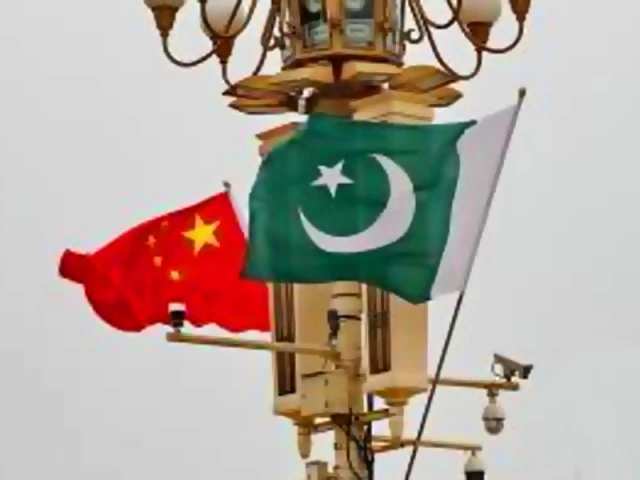Islamabad:
Pakistan has decided to release more than 100 billion rupees to Chinese power plants before the visit of Prime Minister Shehbaz Sharif, reducing the contributions in circulation of almost a quarter in order to respond to one of the main concerns of Beijing.
According to officials, the Ministry of Finance has ordered that payments are made from subsidies from the electricity sector allocated in the current financial year. The 100 billion RS should be disbursed among Chinese power producers in the coming days.
In addition to the RS100 billion, an amount of 8 billion rupees is also granted by regular budget allowances to Chinese power producers.
Development intervened a few days before the departure of Prime Minister Shehbaz Sharif, who went to China this weekend to attend the Shanghai cooperation organization meeting (SCO).
The Prime Minister should also participate in an investment conference organized by the Pakistan Embassy. The sources indicated that the Prime Minister had given instructions to the Ministry of Finance to compensate for the 100 billion rupees to Chinese independent power producers (PPI) by August 25.
In June of this year, the exceptional contributions of Chinese-Pakistani electricity projects (CPEC) amounted to 423 billion rupees. After the injection, Chinese contributions would reduce a quarter to just over Rs300 billion.
There was a slow increase in exceptional Chinese contributions during the last financial year, but contributions still accumulated.
Since 2017, the country has already paid 5.1 billions of energy costs from the 18 Chinese power plants, which were equal to 92.3% of the amount billed, including interest. Pakistani authorities believe that the remaining real cost of energy was less than 300 billion rupees and that the rest of the amount was due to late payment supplements.
The Government is taking nearly 1.3 billion of costs of costs of local commercial banks to remove the circular debt which it owes to power plants belonging to the State, nuclear power plants, private factories and Chinese factories. However, the agreement has not yet been officially concluded.
The unpaid debts of 423 billion rupees are in violation of the CPEC 2015 energy framework agreement, which links the government to fully erase contributions, that the authorities can recover the amounts of end consumers.
In addition to security, non-compliance with CPEC contracts is one of the reasons for the slow increase in financial and commercial relations between the two nations. Under the CPEC energy framework agreement, Pakistan had to create a renewable fund with 21% of power bills to protect Chinese companies against the circular debt crisis.
However, the previous government opened a renewable energy account of Pakistan at the State Bank of Pakistan (SBP) in October 2022 with 48 billion annual allowances. But that limited withdrawals to 4 billion rupees per month, leading to the current debt of 423 billion rupees.
On the allowances of 48 billion rupees for this exercise, the government dealt with 8 billion rupees for the July-August period, sources said.
The 100 billion rupees would be distributed between the Chinese according to their invoicing, according to officials of the Ministry of Energy. They said that the majority of the song would go into the three largest coal power plants.
Pakistan owed 87 billion rupees to the Sahiwal power plant with imported coal, while the company received 1.14 Billion of rupees during the last eight years of its operations. The country also owed 69 billion rupees to the coal Hub Power project, compared to 834 billion rupes of total complaints.
The remaining suspense contributions of the Qasim Port power plant on coal was 85.5 billion rupees, against total invoices of more than Rs1 billion rupees. The contributions of the Thar coal project remained at 55.5 billion rupees. He had claimed 566 billion compulsory compulsory rupees.
The circular debt of the government’s energy sector has decreased by 800 billion rupees by June of this year, thanks to budgetary injections instead of real improvement in sector performance.
The reported reduction in the circular debt (CD) for the financial year 2024-25 is mainly allocated to a single payment of 801 billion rupees rather than any gain of sustained operational efficiency, according to a report by the Federation of the Pakistan Chamber of Commerce and Industry (FPCCI) last week.
He added that this regulation was funded by tax measures, not by improving the performance of the energy sector.
The FPCCI report said that 801 billion rupees had initially been called as targeted direct subsidy for consumers. However, it was rather used to reduce the stock of the circular debt, which can distort the perception of the public by overestimating the success of the reforms and by sub-reporting the advantages that consumers should have received directly, according to the FPCCI.
Although the title suggests a net reduction in circular debt, the inclusion of a deactivation adjustment – such as adjustments of the previous year and others totaling 358 billion rupees – hardly raging the real trajectory, the report indicates. Excluding the payment of 801 billion rupees and the temporary relief of these adjustments, the circular debt has in fact increased by around 379 billion rupees, he added.




